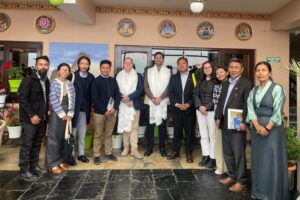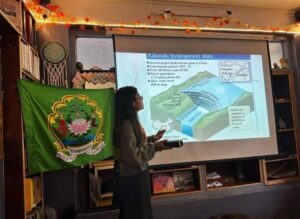Tibetan Women’s Association gave Awareness talk on Tibet’s mighty Rivers at TCV School, Gopalpur on 24th September, 2017 (World River’s Day)
༄༅། ཕྱི་ལོ་༢༠༡༧ ཟླ་༩ ཚེས་༢༤ འཛམ་གླིང་གཙང་པོའི་ཉིན་མོར་བོད་ནང་གི་གཙང་པོའི་གནད་དོན་དང་དེ་འབྲེལ་བོད་ཀྱི་ཁོར་ཡུག་ཐོག་ལས་འགུལ་གྷོ་པལ་སྤུར་སློབ་གྲྭ་རུ་སྤེལ་ཡོད།
Tibetan Women’s Association gave Awareness talk on Tibet’s mighty Rivers at TCV School, Gopalpur on 24th September, 2017 (World River’s Day)
World River’s day is celebrated globally on the last Sunday of September every year. It is the celebration of world waterways wherein to give awareness on the significance and values of the rivers around us. The rivers in every country are on the verge of threat and they are being polluted with the modernization resulting in the harmful effects of our own fresh drinking water source. Thus, each and every citizen in the world should have the responsibility to keep the river systems clean and healthy so as to ensure the good health and hygiene of every human, plant and animals sustaining on this earth.
Environment and Development Desk Officer Ms.Dawa Dolma and Vice President Ms.Tsering Dolma has organized a presentation and discussion for class 12 students of TCV School, Gopalpur on World Rivers Day with the theme “If Tibet Dries, Asia Dies”.
We visited the school with a mission to educate the young students to have knowledge and awareness about the importance of Tibet’s rivers to the Asian nations and the world as well. Tibet being the roof the world is a source of fresh water to many downstream nations and yet due to various Unsustainable Developments initiated by China and climatic changes deteriorates Tibet’s fragile Environment and pollutes its river system.
The actual program started at 10 AM on Sunday, 24th September, 2017 at TCV, Gopalpur hall with a brief introduction about Tibetan Women’s Association by Vice President, Ms. Tsering Dolma followed by screening of a short video clip about Tibet’s river and then Environment officer, gave a detailed presentation about the significance of the Tibet’s river to Asian downstream nations.
Following are the various topics that are presented before the students which includes,
- World River’s day is celebrated in order to bring awareness about values of rivers around the globe which is on the verge of threat. It is the habitats of many organisms.
- Various names for the Tibetan Plateau which includes; Asia’s Water Tower, Rain Maker, Roof of the World, Ice box of Asia, Asia’s freshwater bank, Third Pole and Western Treasure house.
- Importance of the “3rd Pole” in which Tibet is home to largest store of fresh water outside the Arctic and Antarctic.
- Water Tower of Asia and its downstream nations where Tibet’s rivers feed 1.4 billion Asian people which constitutes over 20% of world population.
- Present situation of Tibet’s Rivers under the Chinese’s excessive mining, damming, water diversion and hydro power projects, unsustainable developments and increasing number of tourists in Tibet.
- Forced Resettlement of Tibetan Nomads where under the Resettlement Scheme, Tibetan traditional nomads are being removed from their nomad zone in the name of over grazing and shifted into a towns where they are provided with very limited space for housing with no space for herding and grazing their yaks and sheep.
- China’s Mismanagement of Tibetan Rivers results in threats to Asia’s water security, relocation of over 23 million people around the globe due to damming, retreating of Tibet’s glaciers which is the main sources of water to mighty rivers like Machu, Drichu, Zachu and 4 Khababs.
- There are certain solutions and recommendations to address the threats to Tibet’s river which includes stopping of mining activities, damming for water diversion and hydro power projects and halt traditional nomad’s resettlement programs. Chinese’s water treaties must rise above the narrow national strategic goals and economic development and must respect traditional Tibetan’s lifestyle and their reverence to environment. Tibetan plateau and Asia’s ecosystem must be considered as a common ecosystem by the world as well.
After the presentation, we divided the students into 10 groups in order to educate them further and also to check how much they learned and understood from the presentation. It is really appreciative of them by actively participating in the discussion and showing their full enthusiasm with their creative messages and slogans about environment and rivers.









